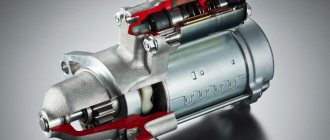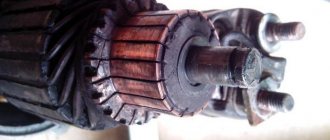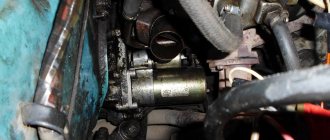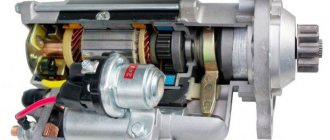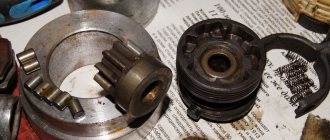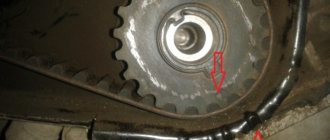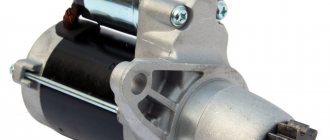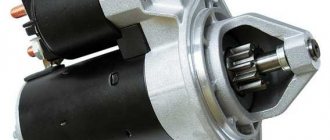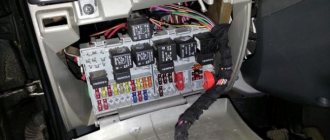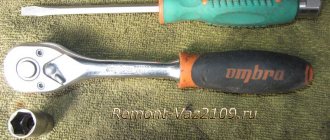The car starter is an electric motor that is powered by the battery. The starter's job is to engage the flywheel of the internal combustion engine to turn the crankshaft and then start the engine. During engagement with the flywheel (braking torque), the car starter takes on an electric current of about 350 A.
This device is designed for short-term operation; prolonged rotation of the starter significantly reduces its service life. Note that a fully serviceable engine starts from the starter almost immediately, without the need to rotate the crankshaft for a long time. In the cold season, up to 2 attempts to start the internal combustion engine from the starter are allowed.
Types and design of electric starter relay
There are three types of starter relay:
- blocking (preventing the device from starting when the engine is running);
- unloading (converting lower currents into stable 12 V);
- retractor (traction), which is attached directly to the starter.
The first two are certainly important, but they are not installed on every car, unlike the “traction” one, without which the engine will not start.
The traction electromechanical relay is responsible for:
- The bendix is thrown into engagement with the flywheel.
- Closing and holding the bridge between the “plus” of the relay and the starter.
- Stable power supply to the brush assembly of the electric starter.
- Timely shutdown of the trigger mechanism.
Starter solenoid relay diagram
Inside, it is arranged simply: under the metal body there is a two-winding coil with a core. On the one hand, the body has a protruding rod (the pulling end of the armature), on the other, an ebonite cover with three terminals (2 powerful contact bolts and one “pin”). The lower bolt is connected to the plus of the electric starter by a power wire (oblique). The armature - a metal core - “walks” longitudinally inside two windings (coils): “retracting” (VO) and “holding” (CU). When retracted, it presses on a movable electrode, at the end of which a spring-loaded copper contact plate is attached. At the end of the armature (core) stroke, the plate is pressed against the “nickels” of the bolts, closing a short circuit - from one to the other, and then to the electric starter brushes.
The edge of the core is connected to a fork lever that moves the Bendix gear forward. In the non-working position, it protrudes far from the body, and when current is supplied to the pulling coil, it goes under it, “pulling” the upper edge of the “fork” behind it. Swinging on the axis, its lower edge moves forward - carrying out, through the driving clutch, the Bendix (gear with a freewheel) into engagement with the teeth on the flywheel crown. When this happens, a metallic knocking or clicking sound is heard.
Working principle of VR
A constant plus is supplied from the battery to the upper power bolt of the “traction” bolt. In the free state, the contact plate does not touch the “nickels” of the power bolts in the cover. Both windings – the pull winding (VO) and the holding winding (CU), are connected with one terminal to a small “control” terminal, which receives the starting pulse from the ignition key (plus). The second output - a more powerful VO - goes to the jumper with the lower power bolt (plus of the starter electric motor), and the OU - to the “ground” (housing).
Starter connection diagram
As soon as the ignition key closes the power supply circuit to the VO, the current in it will create a magnetic field, under the influence of which the core will move inside the housing, push the bendix forward, and press the plate to the terminals. The plate will create a “short path” for high voltage current - from the top bolt, to the bottom and to the starter brushes. When the current flows through it, the “minus” disappears from the traction winding. Now only the holding one starts working, which is still energized (and will be as long as the ignition key remains in the “Start” position).
Why does the relay click but the starter does not turn the engine?
A single click “indicates” that the retractor winding is working, the bendix is “out.” If after this the gear does not turn, either the car starter itself is faulty, or the freewheel has failed. If the retractor often “shoots” with the bendix, it means that the problem is in the holding coil, which is unable to “pick up” the core when the pulling coil has already turned off.
In order for the car engine to start, the Bendix needs to spin with good force, while being in clear engagement with the teeth of the flywheel ring.
The force is fully provided by the electric starter motor, but the relay “opens the way” for it, so the stable operation of the devices is interconnected. If the starter clicks, the problem is definitely not in the retractor winding.
Possible breakdowns:
- The battery is dead or the terminals are not tightened.
- There is no stable “mass” for VO.
- Starter armature short circuit.
- Loss of conductivity on nickels.
- The brushes crumbled.
- The general “mass” (battery) has come off.
To quickly check one problem unit - with a screwdriver or a wrench - tap 2-3 times (shortly, sharply, but not hard) on the solenoid relay body, closer to the cover. Loss of conductivity often occurs from misalignment of the plate that closes the heels. This will force her to return to her place.
Where to look for the reason?
Knowing the operating principle of the entire circuit, you can easily identify those elements of the circuit with which problems may arise. These include:
It is in this order that the circuit should be checked when looking for the cause.
Battery
Let's start with the battery. One of the reasons for the starter not turning on is a low battery. As a result, its energy is simply not enough to make the electric motor work, although there is enough of it to operate the relay (hence the clicks). An indirect sign of a discharged battery is a strong dimming of the control lamps on the dashboard when trying to turn on the starter.
A malfunction in which the retractor has nothing to do with it
The situation when the starter turns, but the engagement between the teeth of the Bendix gear and the flywheel ring does not work, happens often. Especially after repairs with the replacement of the bendix, or in cars with over two hundred kilometers.
Worn bendix gear
Despite the fact that a click was heard, signaling that the bendix had come out, the length of its stroke was not enough for full contact, and the motor would spin the clutch idle. With this malfunction, you can hear the characteristic buzz of a working starter, vigorous, but ineffective. Neither from the second nor from the tenth start will it be possible to get rid of the problem - you need to remove the electric starter, check the pushing force of the “traction”, the condition of the teeth on the bendix and the starter ring of the flywheel.
Reasons for clicking when switching on the ignition
Let's look at the main reasons leading to complete or partial inoperability of the starter:
- problems with the power supply to the starter unit - most often the ground contact is disrupted due to a weakening of the bolted connection or its oxidation. In addition to the starter, the relay, solenoid and main relays are powered to ground, so these components are also subject to checking for quality contact;
- Solenoid relay is faulty. The most likely cause is a winding break/short circuit, and occasionally mechanical failure occurs;
- Short circuit in the starter winding. A typical breakdown for older cars, practically never encountered on cars with mileage up to 100-150 thousand km;
- problems in the contact group - most often it is a blown fuse, but there are conductivity problems in the ignition switch or wiring contacts;
- starter clutch slipping. Since the coupling cannot be repaired, it will need to be replaced;
- The starter drive is clogged, causing it to move along the threads tightly and with difficulty. It can be solved by cleaning and lubricating the thread after disassembling it.
Let's look at typical problems and problematic issues in which the crankshaft of a car practically does not turn or barely turns when the ignition is turned on:
- in winter, such a problem can arise due to the mismatch of the engine oil with the region of use - it thickens and prevents the crankshaft from turning;
- dead battery. It is also more common in winter, since at low temperatures the battery loses its charge much faster;
- The clicking of the starter indicates wear of its brushes, although on some VAZ models there will not even be a clicking sound with this problem.
Occasionally, there are other reasons that lead to the impossibility of starting the engine, regardless of whether it is cold or warm. So, it may turn out that the return spring located in the retractor relay has failed. It is also possible to unstick the stator magnets - this can be cured by disassembling and gluing them together manually.
Let's take a closer look at the main reasons for the starter's inoperability.
The starter makes a few characteristic clicks, but does not turn the engine.
The first scenario for the development of the situation in this case will be the occurrence of several successive clicks. If you listen closer to the unit, you can understand that these clicks are produced by the traction relay. This means that the starter takes an electric charge, but the current only reaches the traction charge, without passing to the engine spin-up mechanism itself.
Such manifestations are perceived by drivers as a discharged battery. The lack of charge in the battery would allow the starter to be cranked lazily once or twice, so this problem is excluded in this case. It is better to pay attention to the following possible problems:
- the traction relay is faulty and does not supply voltage to the starter itself;
- the relay contacts with the main part of the starter are too loose;
- poor ground from the starter to the engine body;
- loose contact on other terminals connected to the starter.
Remember that the correct operation of the device is ensured only by the full functionality of the vehicle's electrical system. All it takes is one small misconception and the starter will click but not turn. Therefore, first of all, if such a problem occurs, check all connections and contacts in the starter. This will help you completely eliminate the problem or force the starter to spin and start the engine once and drive to the diagnostic center.
The starter makes one powerful click and does not turn the engine.
In such a situation, the list of problems comes down solely to the starter itself. We again confirm the fact that the charge is reaching the starter, because the relay clicks. A malfunction of the relay itself is excluded, because some kind of problem is blocking the normal operation of the device.
One powerful click and no further action from the starter may be the cause of an unstable charge being supplied to the device. Try to try to start the engine several times at intervals of 15-20 seconds. You may be able to start the engine. If this does not happen, it is worth investigating the following possible problems:
- the starter bendex is faulty, it is jammed and does not allow the entire device to turn;
- the retractor is broken and does not regulate the starter;
- break in the starter main winding or short circuit inside it;
- The starter brushes or bushings are maximally worn and require immediate replacement.
Typical solenoid relay malfunctions and their symptoms
Open or short circuit in the control circuit. They can happen on any segment - from the ignition switch to the terminal on the VR housing. This category includes: wear of the contact group of the lock itself, a blown fuse, a closed locking relay, a short circuit in the wiring harnesses, oxidation of the terminals in the blocks. Failure manifests itself in different ways. More often - a complete lack of response from the device to startup attempts. Sometimes the starter only clicks at first until the battery runs out.
Burning of the contact group inside the device, due to which a large current does not flow to the brushes of the electric motor, and it does not rotate. Loss of conductivity due to carbon deposits, oxidation of the coins, a broken plate or a plate that has moved out of place is the second most common problem with the starter relay. With such malfunctions, the starter sometimes clicks, but does not turn the gear.
Burnt wires and oxidized contacts of the retractor relay
A break in the holding winding at the point where it is attached to the body - due to which, instead of one operation, a whole “cascade” of useless clicks is heard. Bendix does not have time to engage with the teeth of the flywheel - it is immediately thrown back. At the same time, the car gives a clear picture of short “idle” clutch activations with knocking, howling, crackling or buzzing. The case does not quite fit the definition: “the relay clicks, but the starter does not turn,” but refers purely to the breakdown of the solenoid relay.
VO short circuit - with this breakdown, the starter clicks, but cannot completely push out the bendix and supply power to the lower power bolt (to the brushes). The malfunction is detected only when removed from the car and the coils are checked one by one.
Popular brands:
Infiniti QX80
battery
Since the starter receives power from the car’s battery, we first check the battery. Perhaps it is discharged or its service life has simply reached the end. Checking the performance of the battery is very simple:
- Insert and turn the vehicle ignition key. If at the same time there is not only no “response” from the starter, but also the instrument panel goes out, then the most likely cause is the battery. It's also worth trying to turn on the high beam headlights. If the lights on the panel dim, the battery is low.
- We evaluate the sounds that the car makes after turning the key. If a whole series of clicks is heard, then the battery is indicating a low charge.
- Check the battery terminals and contacts. There may be a current leak, causing the starter to lack power. If the ground contact constantly appears and disappears, then it should be disconnected from the body and cleaned well. It is also worth removing the negative terminal and using a multimeter to check the voltage of the battery outputs. If the device shows less than 9V, then the battery needs to be charged.
Healthy! At the moment of starting the power unit, the starter requires about 200 amperes. If the contact is insufficient, the device will receive too little charge and will not start working.
In this case, everything is quite simple, perhaps the driver forgot to turn off the headlights and the battery was discharged. We charge it or light it and hit the road. But, if there were no prerequisites for a strong discharge, then the problem may arise again. Therefore, it is better to additionally check the generator and make sure that the battery itself is in order.
But the dashboard lights may go out for other reasons.
How to check the solenoid relay
You can check the VR in two ways - without removing it from the car and after removing it together with the starter. If you suspect that the signal from the lock is lost somewhere in the circuit, first carry out a regular test on the car, then, based on the results, the unit can be removed and checked more accurately - with a multimeter.
Check without removing from the car:
- Put the car on the handbrake, make sure it is in neutral gear.
- Turn on the ignition and leave the key in the lock.
- Remove the connector (thin wire) from the control terminal BP.
- Using a screwdriver, close the terminal with the upper power bolt (plus from the battery).
If after this the car starts, the problem is in the control circuit (the pulse from the lock does not reach the terminal). If the starter continues to click but does not turn, check the devices separately. To do this, the “traction” needs to be disconnected from the starter housing (it’s easier to remove them from the car together, and then separate them).
Check after removal:
- Turn the multimeter into audible dialing mode.
- Connect one probe of the device to the control terminal.
- The second one has a lower power bolt (terminal for brushes).
- If there is a signal, the pull-in winding is intact.
- Leaving the first probe on the terminal, attach the second one to the body.
- If there is a signal, the holding coil is also intact.
- Install the device vertically, on the anchor, with the terminals facing up.
- Place the feeler gauges on the bolts - one on the top, one on the bottom.
- Press the relay, pressing the armature all the way.
- If there is sound, the power terminals are closed correctly, the plate is working.
- If there is no sound, but the display displays numbers, it does not work. The reason is external resistance.
Checking the solenoid relay with a multimeter
If at least one breakdown is detected, the part is replaced with a new one or a known good one. If both coils are intact, and the plate closes the “nickels” normally, all that remains is to test the force with which the spare part moves the armature plunger. To do this, first measure the free play of the plunger by inserting the relay into place in the housing until the loop tightly touches the fork lever, and use a ruler to measure the distance between the electric starter housing and the retractor itself. Pull out the part, push the plunger in until it touches the spring, now set the resulting distance on the plunger from the edge of the body. Mark (with marker or awl).
From the equipment you will need: a charged battery, three pieces of wire with a cross-section of 2 squares, with alligator clips and a plug for the control terminal (connector 50).
Strength check:
- Fix two wires with one end to the “ground” (body) of the part.
- Connect one of these wires to the negative terminal of the battery.
- Place the third wire with the plug on the positive battery.
- With one hand, press the part to the surface, “squeezing” the plunger to the mark.
- Place the plug on connector 50.
- Touch the end of the free wire (from the housing) to the lower power bolt.
- If the core overcomes the resistance and retracts, there is no problem, the retractor relay is working.
To evaluate the force, you need to securely fix the device (by the loop on the anchor) on a flat, solid base. The surface should not conduct current - for example, a wooden or cardboard-covered table.
Lack of contact in the starter circuit
Occurs as a result of metal corrosion or loosening of bolted wires. In addition, you need to check the grounding of the retractor and main relay of the starter assembly. You can check your car's electronics using a multimeter. Before doing this, inspect the wiring, tighten the bolts and check the terminals. If there is contact loss, restore their integrity.
Troubleshooting methods
If the check reveals a short circuit, it is easier to immediately replace the part with a new one. To restore normal conductivity on the “nickels” and correct a break in the holding winding at the fastening point, disassemble the spare part, desolder the terminals, clean the copper from oxide, reassemble, and tighten the fasteners.
Depending on the manufacturer and year of manufacture, the solenoid relay comes with a detachable housing (the cover of the power contacts is secured with screws) and with a one-piece housing (rolled into the metal of the housing). Diagnostics of both types of parts can be carried out without opening them, but there is a problem with repairs: with “one-piece” parts, the body is very difficult to assemble neatly and can easily be damaged during assembly. A cracked cover is unsuitable for further use. If you have little experience in fine work with electromechanical devices, it is easier to purchase a new, known working relay.
